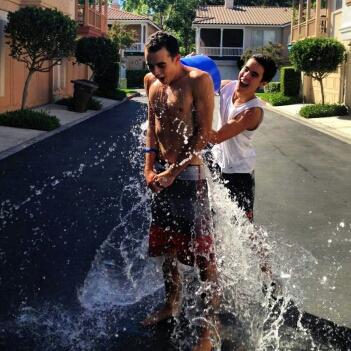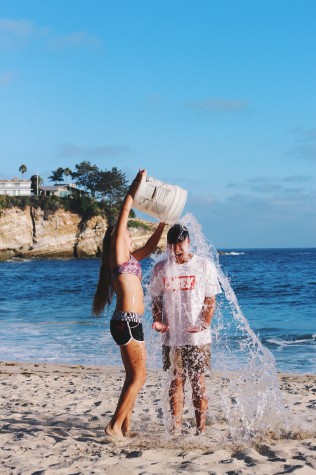Take a chill bucket
Students and faculty help raise awareness for rare disease with ALS Ice Bucket Challenge.
That’s right. Yet another social media craze that has seemed to come and go. Another thing that used to clog your news feed has died out. But this time, it’s our responsibility to keep the momentum going with actual help and support.
Amyotrophic Lateral Sclerosis (ALS), more commonly known as “Lou Gehrig’s disease”, is a neurodegenerative disease that affects the nerve cells in the brain and spinal cord. People who have the disease start progressively lose bodily functions, starting with their arms and legs. In many cases, ALS leads to death. The ALS Ice Bucket Challenge is a national phenomenon helping to raise awareness for this rare disease.
Pete Frates, former Boston College baseball player who was recently diagnosed with ALS, started the Ice Bucket Challenge. He and his support squad, “The FrateTrain”, challenged people to either donate to the ALS Foundation or dump a bucket of ice water over their heads and share it on social media.

Chillin’ for charity- Senior Jason Ford Jr. takes the ALS Ice Bucket Challenge with the help of senior Alex Tatman.
“I first heard about the ALS Ice Bucket Challenge on Instagram, but didn’t know much about it,” said senior Jason Ford. “When I saw the Pete Frates video, I came to see what exactly ALS is and just how the challenge actually helps people of the ALS community.”
To some, the ALS Ice Bucket Challenge may seem like a gimmick to get out of donating money to the foundation and a waste of water while California is in a drought. However, the stats do not lie. Since the inception of the ALS Ice Bucket Challenge, donations to the ALS Association have skyrocketed, with an increase of over $10 million.
“When I was first nominated, I wondered if the videos were even helpful at all,” said senior Jack Jennison. “Then the next morning while my mom was watching the news, I overheard that donations for ALS research had nearly doubled because of the ice bucket challenge and that was amazing to me.”
This growth was not only due to the vastness of media attention the challenge received, but also the type of attention it garnered. Well known athletes, entertainers, TV and radio personalities, and even some government officials got in on the act. People like Aaron Rodgers of the Green Bay Packers, Jimmy Fallon and the Roots Band of The Tonight Show, and former President George W. Bush have released videos of their participation.
“To see that it has gotten so much attention and the different ways people are doing it is just unbelievable,” Ford said. “Especially guys like Paul ‘BizNasty2.0’ Bissonnette from my Arizona Coyotes. His was absolutely insane.”
The most important thing to do is to remember to donate. The challenge becomes more effective this way. If you post a video of yourself on social media completing the ALS Ice Bucket Challenge and nominate three others to accept the challenge, you raise awareness.
Now believe me, you raise awareness from doing this challenge just by taking that freezing bucket of ice water and posting it on social media. You make a difference, indirectly, in a way. By posting it on social media and challenging three other people, you make three other people and those who watch your video aware of ALS. This is a great thing; ALS is not a disease that is known for being in the spotlight.

Chill at the beach – Senior Andrea Laliena dumps a bucket of ice water on senior Adam Campbell.
But now that the novelty of the Ice Bucket Challenge has faded, that does not mean we need to stop raising awareness or stop donating. Sometimes, these things can go from awareness to a fad, like Kony 2012 for example. Everyone was so bent on trying to stop Kony and his child armies for a couple of months, then what? People forgot, word stopped getting spread, and it died off and became a fad. We cannot let this happen to ALS.
This does not mean we need to keep pouring buckets of ice over our heads every day. However, it does mean that whenever you see someone fighting, to give some encouragement and tell them to keep fighting. If you are at a grocery store, and you see a bucket for donations for people fighting ALS, give something. This doesn’t mean you have to give your entire wallet, just a couple of dollars or some loose change helps this cause.
To a member of the ALS community, your individual investment means so much more than you could know. Anthony Carbajal was diagnosed with ALS a little over five months ago. He is a third generation fighter, after his mother and grandmother were also both diagnosed. When Anthony sees people dump those buckets over the top of their heads, it is a very huge deal.
“It is life changing,” Carbajal said. “We are so thankful, thank you so much.”
So next time you see an #ALSIceBucketChallenge, know that it is not a waste of water, but it actually really does give hope to the ALS community.
To make a donation to the ALS foundation, go to their website ALSA.org.





Thato amelia • Aug 20, 2022 at 7:01 am
My first symptoms of ALS occurred in 2014, but was diagnosed in 2016. I had severe symptoms ranging from shortness of breath, balance problems, couldn’t walk without a walker or a power chair, i had difficulty swallowing and fatigue. I was given medications which helped but only for a short burst of time, then I decided to try alternative measures and began on ALS Formula treatment from Tree of Life Health clinic. It has made a tremendous difference for me (Visit w w w. treeoflifeherbalclinic .com ). I had improved walking balance, increased appetite, muscle strength, improved eyesight and others. ]